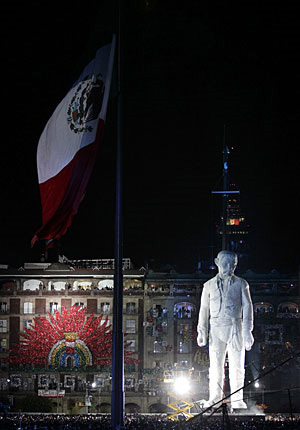
|  |  |  News Around the Republic of Mexico News Around the Republic of Mexico  
Who Was That Mustachioed Mexican Giant?
 Ken Ellingwood - Los Angeles Times Ken Ellingwood - Los Angeles Times
go to original
September 23, 2010


| | On the night of the main bicentennial celebration in Mexico City, El Coloso was paraded in sections before tens of thousands of revelers. At the end, he was lifted to his full stature in the main plaza. (Henry Romero/Reuters) |  |
The 60-foot-tall figure known as El Coloso has fascinated Mexico since Independence Day festivities. Was it Vicente Fox? Zapata? Or someone less admirable?

Mexico City — The floats danced with whimsy. The fireworks wowed. The light show rocked.

But a week after Mexico's bicentennial bash, inquiring minds have obsessed on another spectacle: Who was the really tall guy built of steel and off-white plastic? And (since this is conspiracy-minded Mexico), is the government concealing his real identity?

The giant's name is El Coloso, or Colossus, a 60-foot-tall, square-jawed figure assembled by creators Jorge Vargas and Juan Carlos Canfield for Independence Day festivities.

On the night of the main celebration in Mexico City, El Coloso was paraded in sections before tens of thousands of revelers. At the end, he was lifted to his full, Paul Bunyanesque stature in the main plaza, where he towered over President Felipe Calderon's big "Viva Mexico!" finale.

Since then, people have kept talking about the 8-ton figure with the stern visage and a robust mustache worthy of rocker Freddie Mercury. Bloggers and others have turned an idle question — who does it look like? — into an oddball mystery. No guess seems too wacky.

Many people spot a resemblance to Soviet leader Josef Stalin. Others see Mexican revolutionary Emiliano Zapata, who is on people's minds in part because this year also marks 100 years since the Mexican Revolution.

Was El Coloso modeled after (mustachioed) former President Vicente Fox? Ranchera crooner Vicente Fernandez? Slain presidential candidate Luis Donaldo Colosio?

Maybe it's the effect of the country's drug war, but some people insist he resembles Jesus Malverde, patron saint of narco-trafficking. Someone suggested playfully via Twitter that the statue was really a Trojan horse — once inside the security perimeter of the plaza, or Zocalo, drug-gang hit men would come pouring out.

As speculation took off, officials at the Education Ministry, which oversaw the bicentennial festivities, had enough. On Sunday, the agency issued a disclaimer: El Coloso wasn't Zapata. Nor Stalin. Nor Fernandez. Nor Colosio. El Coloso was no one — and everyone.

"El Coloso is a tribute to the hundreds of thousands of nameless Mexicans, almost all poor peasants, who took part in the independence movement and wrote a central chapter in Mexican history," the ministry said, adding that the designers drew on facial features from all over. "El Coloso's face … has no specific identity."

But (since this is conspiracy-minded Mexico), the official denial seemed only to fuel the fun, prompting bloggers and journalists to hunt for signs of untruthfulness. It didn't take long.

The daily Excelsior newspaper dug up a weeks-old interview in which sculptor Canfield said there was indeed a real-life model. It was Benjamin Argumedo, a revolution-era general whose checkered history includes switching sides to fight against the revolutionary heroes and ordering the killing of Chinese immigrants in northern Mexico. Argumedo ended up before a firing squad, executed as a traitor.

The designers were drawn to Argumedo's lanky physique and a strong, expressive face that showed "war and hunger and hardships," Canfield said. "We took his anatomy, his face, his character; we tried to reproduce it and in the end adapted it to the identity we were looking for."

Case closed, then? Hardly.

Opposition politicians seized on the comments to criticize the Calderon government for choosing a model that one historian labeled "pathetic."

Education Minister Alonso Lujambio, already facing criticism over the bicentennial celebration's $54-million price tag, dismissed the discussion over El Coloso as "useless."

During a radio interview Tuesday, Lujambio played down similarities to Argumedo but said that, in the end, people will see what they choose.

Amid the hubbub, El Coloso has been nowhere to be seen. He was removed from the Zocalo soon after the party to protect him from the weather.

Education officials say they hope to find an indoor space big enough to let the giant face his eager public again.

ken.ellingwood(at)latimes.com

Cecilia Sanchez of The Times' Mexico City Bureau contributed to this report.
|

 |
|  |



